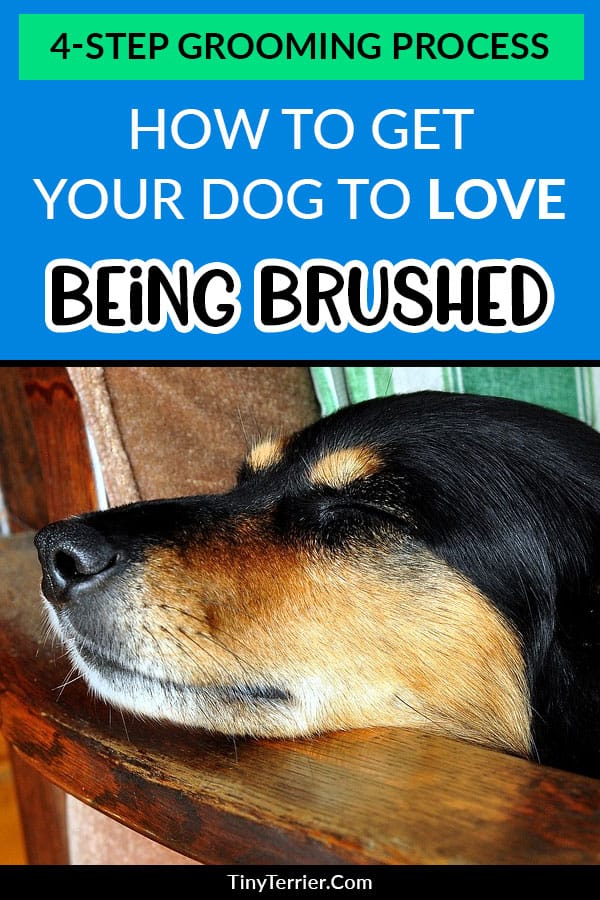How to Groom a Dog that Hates Being Groomed

Updated on February 20th, 2019
Disclosure: This post contains affiliate links, which means that I will earn a commission if you click through and make a purchase (at no additional cost to you).
If you have a dog with long fur or one with hair prone to matting, then you will need to establish a grooming routine to keep their coat healthy.
For some dogs, this is easier said than done.
If you’ve only recently welcomed your dog into your home then you don’t know if they are used to being brushed – or worse, if they have had bad grooming experiences that leave them fearful or reactive.
One of my dogs hated being groomed. He wouldn’t get aggressive, but he would make lots of fearful noises and he tried to ‘mouth’ us when we got the brush close to his mouth.
Grooming was a stressful experience for him and us, which meant that it never got done as often as it should have.
However, by following the steps outlined below we have managed to turn this around and he now enjoys being groomed. It’s even a little difficult sometimes as he loves is so much that he lies on his back so that his belly can be brushed and then he dozes off in that position!
Top tips for brushing a nervous dog
Here is my four-step process for grooming a dog that hates to be groomed!
I’ve used this method on my dogs to turn brush time into something fun for all of us instead of a stressful experience that got my fingers nibbled!
Step 1: Create a distraction
If your dog has had bad experiences with grooming in the past, then they may be scared or reactive when they see you get the brush out.
Your first step towards a positive grooming experience will be simply getting the dog used to you touching them with the brush. This doesn’t necessarily mean running it through their fur, but just putting it against them so that they can feel it and become familiar with it.
One of the best ways to first achieve this is with a distraction – and what better way to distract a dog than with food?
The Chase ‘n’ Chomp Sticky bone is AMAZING for dog grooming.
[amazon box=”B00D0S4MOY” template=”horizontal”]
Fill it with cream cheese, peanut butter or Kong paste and stick it to a surface such as tiles in bathroom, to a laminate or vinyl floor or to your fridge.
Your dog will be so distracted by getting out every morsel of the tasty treat that they probably won’t pay any attention to you brushing them!
As your dog becomes more comfortable with being groomed you might find that you don’t need to use this anymore, but it’s certainly a great starting point for helping your dog to overcome their fear of being brushed.
Step 2: Prepare the coat
If your dog’s fur is matted or long, then preparing the coat before brushing can stop the brush from pulling so much – just like adding conditioner to your own hair.
I’m currently using this ‘Pet Head’ dry shampoo. It smells like blueberry muffins!!
Simply spritz the fur, give it a little rub to help work it in (if your dog doesn’t mind being fussed), and then begin grooming whilst the fur is still damp.
The yummy smell this dry shampoo leaves behind is a welcome bonus!
[amazon box=”B00ATOAK7A” template=”horizontal”]
Step 3: Use a gentle brush
My Shih Tzu Socks hates to be groomed with a normal dog brush. Because he has curly fur that doesn’t moult, traditional brushes tend to pull on his skin and cause him discomfort, no matter how careful I am.
One day, I was sorting out the drawers in my bedroom and came across a Tangle Teezer brush that I bought a couple of years ago. I’d never really used it myself so I thought I’d give it a try on the dogs.
The transformation was instant! Suddenly, grooming time became something enjoyable. Socks finds the Tangle Teezer so gentle that he loves it and sees it as an extension of cuddle time! He rolls all around and sometimes even goes to sleep as he is being brushed.
[amazon box=”B008HJRLXK” template=”horizontal”]
The brush works great on my other dog too. Freddie is a Shih Tzu cross Jack Russell terrier and sheds his fur like a JRT. The Tangle Teezer takes out LOADS of dead hair from his coat in a gentle manner that doesn’t hurt or pull.
The Tangle Teezer does a great job on both my dogs’ different types of coat. It’s super-quick AND it doesn’t hurt – so results all round. Plus, it’s an affordable dog brush option and can be bought for under £10.
Step 4: Know when to stop
If your dog is new to grooming then take things slowly in the beginning. If they start to become agitated or uncomfortable then stop grooming them, give them a big fuss and some encouragement and then continue grooming them the next day.
Establishing a routine can help a nervous job to overcome their fear of being brushed. Try brushing them every morning before they have their breakfast, or before you go out for a walk.
Slowly build up the grooming time until you are performing a full brush every time.
Remember to keep you and your dog calm to help them become comfortable with the process.
Before you know it, grooming time will be something enjoyable for the both of you!







